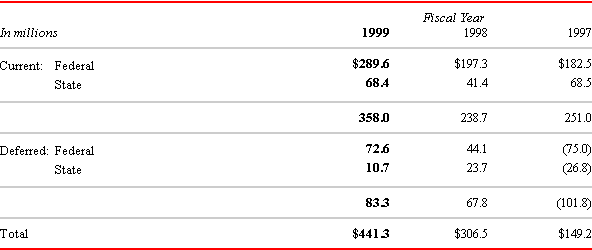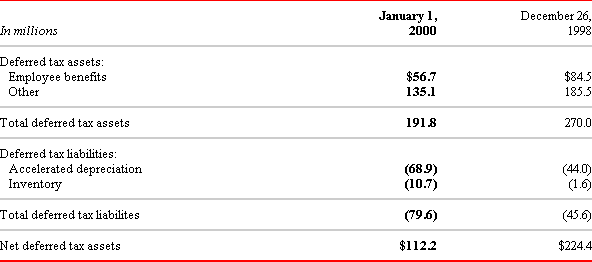| Home | Previous 5 Notes Next 5 Notes |
The Company and its subsidiaries lease retail stores, warehouse facilities, office facilities and equipment under noncancelable operating leases typically over periods ranging from 5 to 20 years, along with options to renew over periods ranging from 5 to 15 years.
Following is a summary of the Company’s net rental expense for operating leases for
the respective fiscal years:
Following is a summary of the future minimum lease payments under capital and
operating leases as of January 1, 2000:
During fiscal 1999, the Company entered into sale-leaseback transactions totaling $229 million as a means of financing a portion of its store development program. The properties were sold at net book value and were typically leased back over periods of 20 years. The resulting leases are being accounted for as operating leases and are included in the above tables.
As of January 1, 2000, the Company had the following stock incentive plans, which include the pre-merger plans of Arbor and Revco. Effective with the mergers, all outstanding Arbor and Revco stock options were exchanged for options to purchase CVS common stock.
1997 Incentive Compensation Plan
As of January 1, 2000, the 1997 ICP provided for the granting of up to 23,382,245 shares of common stock in the form of stock options, stock appreciation rights, restricted shares, deferred shares and performance-based awards to selected officers, employees and directors of the Company. All grants under the 1997 ICP are awarded at fair market value on the date of grant. The right to exercise or receive these awards generally commences between one and five years from the date of the grant and expires not more than ten years after the date of the grant, provided that the holder continues to be employed by the Company. As of January 1, 2000, there were 17,915,519 shares available for future grants under the 1997 ICP.
Restricted shares issued under the 1997 ICP may not exceed 3.6 million shares. In fiscal 1999, 1998 and 1997, 14,402, 155,400 and 44,610 shares of restricted stock were granted at a weighted average grant date fair value of $50.88, $37.80 and $23.02, respectively. Participants are entitled to vote and receive dividends on their restricted shares, although they are subject to certain transfer restrictions. Compensation costs, which are recognized over the restricted period, totaled $2.3 million in 1999, $3.1 million in 1998 and $3.5 million in 1997.
The 1996 Directors Stock Plan
Following is a summary of the fixed stock option activity for the respective fiscal years:
Following is a summary of the fixed stock options outstanding and exercisable
as of January 1, 2000:
The Company applies APB Opinion No. 25 to account for its stock incentive plans. Accordingly, no compensation cost has been recognized for stock options granted. Had compensation cost been recognized based on the fair value of stock options granted consistent with SFAS No. 123, net earnings and net earnings per common share ("EPS") would approximate the pro forma amounts shown below:
The fair value of each stock option grant was estimated using the Black-Scholes Option Pricing Model with the following assumptions:
1999 Employee Stock Purchase Plan
Employees pay for the shares ratably over each offering period through payroll deductions. During 1999, options for 210,833 shares were exercised at an average price of $33.42.
The Company sponsors a noncontributory defined benefit pension plan that covers certain full-time employees of Revco who are not covered by collective bargaining agreements. On September 20, 1997, the Company suspended future benefit accruals under this plan. As a result of the plan’s suspension, the Company realized a $6.0 million curtailment gain in 1997. Benefits paid to retirees are based upon age at retirement, years of credited service and average compensation during the five-year period ending September 20, 1997. The plan is funded based on actuarial calculations and applicable federal regulations.
Pursuant to various labor agreements, the Company is also required to make contributions to certain union-administered pension and health and welfare plans that totaled $8.4 million, $7.5 million and $7.6 million in fiscal 1999, 1998 and 1997, respectively. The Company may be liable for its share of the plans’ unfunded liabilities if the plans are terminated. The Company also has nonqualified supplemental executive retirement plans in place for certain key employees for whom it has purchased cost recovery variable life insurance.
Defined Contribution Plans
Other Postretirement Benefits
Following is a reconciliation of the benefit obligation, fair value of plan assets and funded status of the Company’s defined benefit and other postretirement benefit plans as of the respective balance sheet dates:
(1) Plan assets consist primarily of mutual funds, common stock and insurance contracts.
Following is a summary of the net periodic pension cost for the defined benefit and other postretirement benefit plans for the respective fiscal years:
For measurement purposes, future healthcare costs are assumed to increase at an annual rate of 9.0%, decreasing to an annual growth rate of 5.0% in 2004 and thereafter. A one percent change in the assumed healthcare cost trend rate would change the accumulated postretirement benefit obligation by $0.9 million and the total service and interest costs by $0.1 million.
![]()

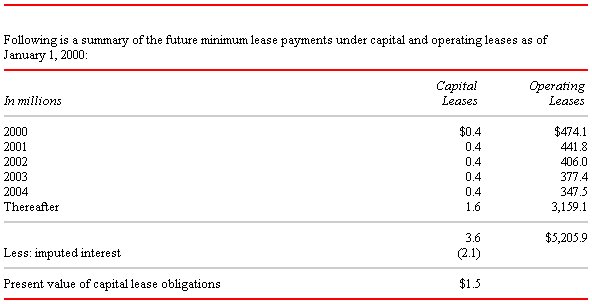
![]()
The 1997 Incentive Compensation Plan (the "1997 ICP") superceded the 1990 Omnibus Stock Incentive Plan, the 1987 Stock Option Plan and the 1973 Stock Option Plan (collectively, the "Preexisting Plans"). Upon approval of the 1997 ICP, authority to make future grants under the Preexisting Plans was terminated, although previously granted awards remain outstanding in accordance with their terms and the terms of the Preexisting Plans.
The 1996 Directors Stock Plan (the "1996 DSP") provides for the granting of up to 346,460 shares of common stock to the Company’s nonemployee directors (the "Eligible Directors"). The 1996 DSP allows the Eligible Directors to elect to receive shares of common stock in lieu of cash compensation. Eligible Directors may also elect to defer compensation payable in common stock until their service as a director concludes. The 1996 DSP replaced the Company’s 1989 Directors Stock Option Plan. As of January 1, 2000, there were 247,071 shares available for future grant under the 1996 DSP.
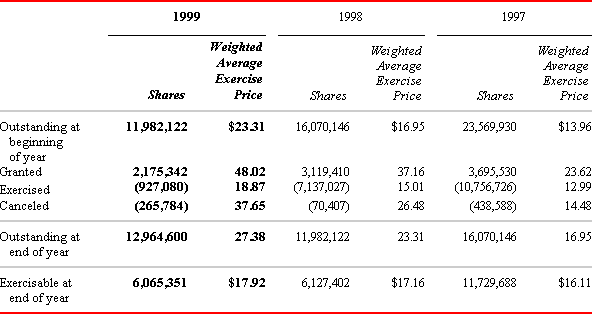
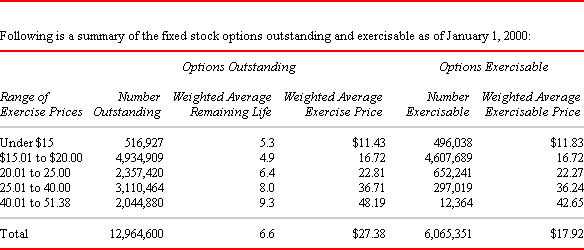
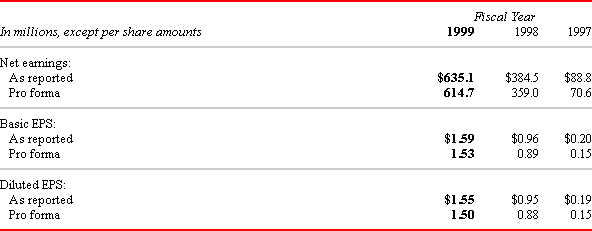

The 1999 Employee Stock Purchase Plan provides for the granting of up to 7,400,000 shares of common stock. The plan, which covers substantially all employees, gives employees the option to purchase common stock at the end of each six-month offering period, at a purchase price equal to 85% of the lower of the fair market value on the first day or the last day of the offering period.
![]()
The Company sponsors a Profit Sharing Plan and a voluntary 401(k) Savings Plan
that covers substantially all employees who meet plan eligibility requirements.
The Company makes matching contributions consistent with the provisions of the
plan. The Company also maintains a non-qualified, unfunded Deferred Compensation
Plan for certain key employees. This plan provides participants the opportunity
to defer portions of their compensation and receive matching contributions that
they would have otherwise received under the 401(k) Savings Plan if not for
certain restrictions and limitations under the Internal Revenue Code.
The Company’s contributions under the above defined contribution plans
totaled $17.0 million, $26.4 million and $24.1 million in fiscal 1999,
1998 and 1997, respectively. The Company also sponsors an Employee Stock
Ownership Plan. See Note 9 for further information about this plan.
The Company provides postretirement healthcare and life insurance benefits to retirees who meet eligibility requirements. The Company’s funding policy is generally to pay covered expenses as they are incurred.

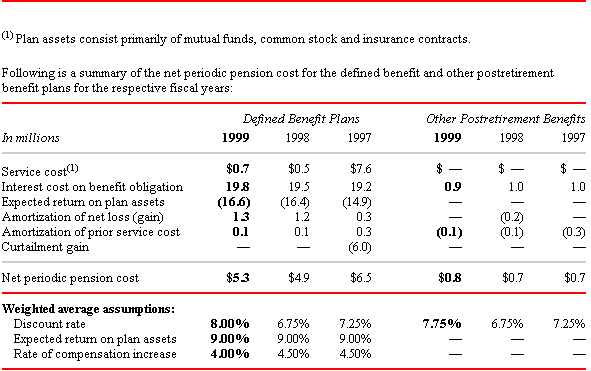
(1) The decrease in total service cost is primarily due to the suspension of future benefit accruals under the Revco pension plan during 1997.
| Back to top | Previous 5 Notes Next 5 Notes |

